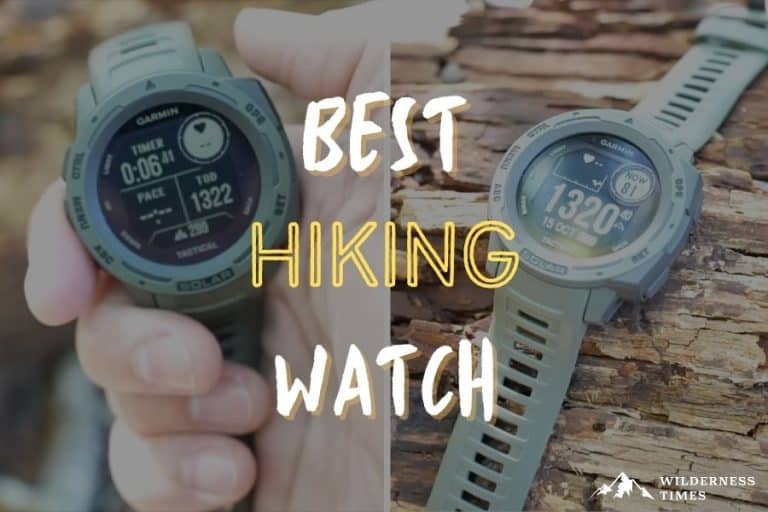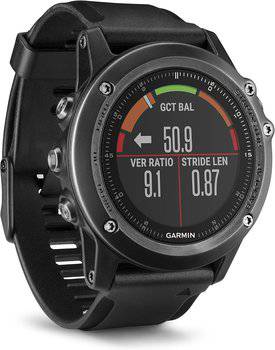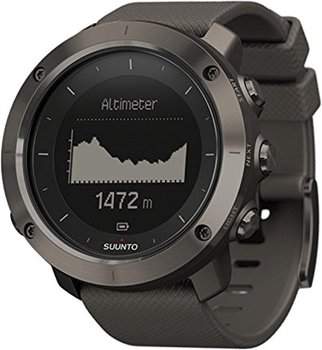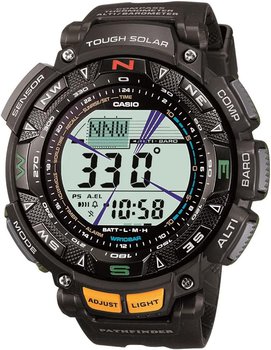If you’re in a rush, I recommend the Garmin Fenix 3 as the best hiking watch available today.
Since the advent of the Apple Watch, smart watches have been booming. Specifically, in the outdoors world, these tools have become quite the staple with tech-savvy hikers. They can help you track how far you hiked, how high up you are, and which direction you’re facing.
Hiking watches are clearly useful, but they can come with a hefty price tag. So, to make sure you don’t throw your money away, today I’ll give a comprehensive breakdown of my five favorite hiking watches.
Best Hiking Watch: Our Top Recommendations
- Best Hiking Watch Overall: Garmin Fenix 3
- 2nd Best Choice: Suunto Traverse
- Best for Long Battery Life: Casio Pathfinder
- Most Rugged Hiking Watch: Garmin Instinct
- Best Retro Hiking Watch: Garmin Foretrex 401
- Best for Multiple Sports: Suunto 9 Baro
- Best Design: Polar Grit X
- Best for Mountain Athletes: COROS APEX 42MM
- Best with Coin Cell Battery: Timex Expedition Grid Shock
Garmin Fenix 3
Weight: 3.2 oz | Waterproof: water-resistant | Dimensions: 2″ x 2″ x 0.6″ | GPS: yes | Smartphone Compatible: yes | Battery Life: up to 40 hours
Let’s start with my daily driver, the Fenix 3 from Garmin. One reason I chose it in the first place is its 100-meter waterproof capabilities. Whenever I go camping near a lake, I like to make the most out of the swimming opportunity — and even after four years, this watch is still alive.
Its Chroma display also ensures that everything is clearly legible even under harsh sunlight. Further, the omnidirectional steel antenna makes its GPS both faster and more accurate. The watch automatically syncs my data whenever connected to Wi-Fi, which is very handy when monitoring hike data.
If there’s one thing I’d change on this watch, it’s the battery, since it only lasts 20 hours while the GPS is running. That’s barely two days if you make a one-night camping trip.
That said, Garmin isn’t precisely known for market-leading battery life, and this unit can last six weeks if you set it to watch mode, so it’s not a dealbreaker.
Pros:
- Sunlight-ready Chroma display
- Omnidirectional steel antenna boosts GPS accuracy and speed
- Autosync (requires Wi-Fi)
- TracBack helps you retrace your steps if you get lost
Cons:
- 20-hour battery life on GPS mode (above average for Garmin)
Best for: outdoorsmen who want a well-priced, feature-packed watch that can handle all the elements
Suunto Traverse
Weight: 2.9 oz | Waterproof: water-resistant | Dimensions: 1.97″ x 1.97″ x 0.65″ | GPS: yes | Smartphone Compatible: yes | Battery Life: up to 100 hours
If the battery life of Garmin’s Fenix 3 is your concern, then have a look at the Traverse. It can last up to 100 hours, twice as long as the previous watch we covered.
Pro-tip: Suunto’s Movescout app puts GPS accuracy on the highest setting by default, so lower it to conserve battery.
This watch excels in daily use since it packs functionality needed for everyday urban tasks. Its push notifications keep me updated even when I don’t have my phone on me. The flashlight helps me find items in dark spots, and the step and calorie counter keeps me accountable. Love it!
One thing that really makes this model stand out for me is its barometric trend feature. This essentially predicts the weather and warns you when a storm is coming. No lie – this feature has saved me from getting drenched more than once.
Pros:
- 100-hour battery life
- Push notification functionality when paired with a smartphone
- Flashlight
- Daily, weekly, monthly, and yearly tracking for steps and calories
- Storm warnings
Cons:
- Uncolored display is hard to read in the sun and looks dated
Best for: those looking for a watch that’s just as useful at home as it is in the wild
Casio Pathfinder
Weight: 2.3 oz | Waterproof: water-resistant| Dimensions: 2.3″ x 2″ x 0.6″ | GPS: no | Smartphone Compatible: no| Battery Life: roughly 6 months
Those who want even more out of their battery will be deeply satisfied with the Pathfinder’s six-month capacity. It can also go for much longer than that when you remember it’s solar-powered. Of course, this comes with the tradeoff of not having GPS capabilities constantly pinging the satellite.
Still, for those who carry their phone along anyway, it might not be too big of an issue. The watch has four sensors: an altimeter, a barometer, a thermometer, and a digital compass. This ensures you still get essential info even without GPS capabilities.
While the display might look a little dated, readability isn’t an issue. The LED backlight makes the screen super easy to read even during the darkest nights.
Pros:
- Six-month maximum battery life
- Solar-powered charging makes it nearly impossible to drain this watch
- Quad-sensor
- LED backlight for low-light hikes
Cons:
- Non-GPS
Best for: battery life enthusiasts who don’t need a GPS or who use their smartphone for navigation
Garmin Instinct
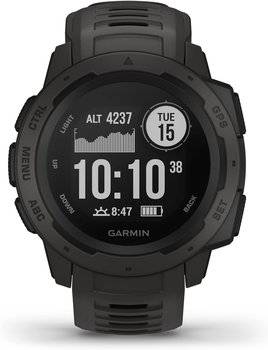
Weight: 1.8 oz | Waterproof: water-resistant | Dimensions: 1.8″ x 1.8″ x 0.6″ | GPS: yes | Smartphone Compatible: yes | Battery Life: up to 14 days
Whenever I go on a trip that includes some rock climbing, this is usually the watch I’ll take with me just for its sheer durability. Its shock resistance is built to US military standard, so you know it can take a beating.
I also have to give it extra points for the stunning design. Despite not having a Chroma display, the interface still feels modern. The way the physical accents on the watch match the digital interface on the screen keeps the look super stylish.
This Garmin model comes in 20 different colors, so you don’t have to worry about a lack of choice. Again, the main drawback is its 16-hour battery life on GPS mode, but that’s a given when you go with this manufacturer. A solar-powered variant does exist, though, so consider that for thru-hikes.
Pros:
- Military-grade durability
- Great design
- Color variety
- Solar-powered (on Instinct Solar variant)
Cons:
- 16-hour battery life on GPS mode
Best for: campers who want the most rugged hiking watch money can buy
Garmin Foretrex
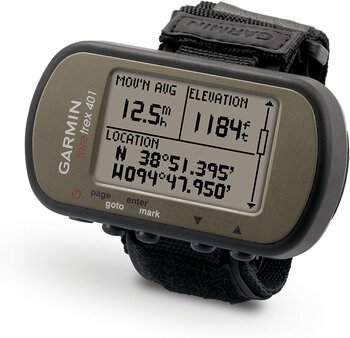
Weight: 3.1 oz | Waterproof: waterproof | Dimensions: 1.7″ x 2.9″ 0.9″ | GPS: yes | Smartphone Compatible: no | Battery Life: up to 17 hours
Pragmatists who don’t mind going retro may want the Foretrex 401 from Garmin. Despite being released in 2004, this model is still an old favorite for many hikers. The nostalgia and functionality have really held up through the years (unlike countless other devices.)
The GPS receiver is definitely up to par, operating in deep canyons and under dense tree cover. It even has hunting and fishing information, which could be useful to survivalists — though Google has taken away from that benefit a bit.
Seeing as this isn’t exactly a new model, it should come as no surprise that it runs on two AAA batteries rather than the sun or a charging cable. This isn’t the end of the world, but be sure to bring spare batteries and keep them dry as they aren’t as waterproof as the watch.
Pros:
- Nostalgic, tried-and-tested design
- Robust GPS receiver
- Native hunting and fishing information
- The UI resembles video games, which could make this a fun unit for kids
Cons:
- 17-hour battery life on GPS mode and requires AAA batteries
Best for: hikers who yearn for nostalgia and prefer AAA batteries to the rechargeable kind
Suunto 9 Baro
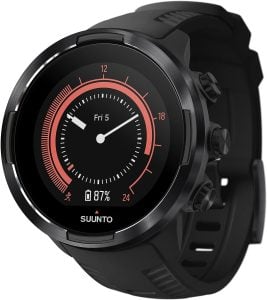
Weight: 2.9 oz | Waterproof: water-resistant | Dimensions: 1.97″ x 1.97″ x 0.66″ | GPS: yes | Smartphone Compatible: yes | Battery Life: 170 hours
This watch is an amazing option, not just for hiking, but for practically any sport. In fact, it features over 80 sport modes, from running and climbing to windsurfing – and even cheerleading! So, whatever activity you are enjoying out in the wilderness, this watch can track it.
This watch works smarter with four different battery modes, ranging from max GPS accuracy to max battery life.
This means you can change the battery life to suit your specific camping, GPS, and battery life needs. In the case of the latter, you can sacrifice a bit of GPS accuracy and display color to keep your watch working for up to 170 hours!
The touch screen is fairly large, so you don’t have to squint when checking your tracked progress.
This screen works in wet weather, and functions with touchscreen compatible gloves in the case of cold weather conditions.
From a durability standpoint, this watch stands out. With glass made from sapphire crystal, this watch face is inarguably the most durable option – even if it is also on the pricier end of our review list.
Pros
- Features different battery modes, with the battery saving mode lasting up to 170 hours
- Water-resistant up to 100 meters (109 yards)
- Features durable sapphire crystal glass on watch face
- Combines GPS and motion sensor data for improved accuracy
Cons
- Very bulky and heavy
Best for: hikers that enjoy plenty of other sports
Polar Grit X
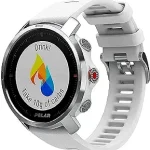
Weight: 2.3 oz | Waterproof: water-resistant | Dimensions: 1.9″ x 1.9″ x 0.5″ | GPS: yes | Smartphone Compatible: yes | Battery Life: up to 168 hours
One thing that attracted me the most to this model is the sleek design – but there’s much more to this watch than its looks!
While it might not look like it, this hiking watch has military-grade durability. Before it hit the market, this model was tested for drops, extreme temperatures, and humidity among other environmental conditions.
Even though it’s so sturdy, this watch is rather lightweight and very comfortable to wear. Not just that, but it also looks really great on your wrist. You can choose between three colors: black, silver, and green, each of them being quite eye-catching.
Another impressive thing about this watch is its precision. It has real-time turn-by-turn route guidance imported from Komoot, which helps you keep on the right track. With this function, the watch will alert you if you’ve started to head in the wrong direction – even if you’re just one foot off your chosen path for the day.
Pros
- FuelWise smart fueling assistant calculates carbs for your session
- Hill Splitter provides you with detailed uphill and downhill stats
- Route guidance imported from the Komoot app
- Shows current weather and a 2-day forecast
Cons
- On the more expensive end of the watches we’ve reviewed
Best for: hikers in need of a durable but lightweight watch
COROS APEX 42MM
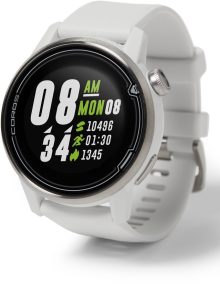
Weight: 1.9 oz | Waterproof: water-resistant | Dimensions: 1.8″ x 1.8″ x 0.5″ | GPS: yes | Smartphone Compatible: yes | Battery Life: 25 hours
If you’re a mountain athlete, then this model by COROS offers everything you need, including durability, functionality and a really good battery life.
Starting with the design, this watch is made to take a beating. While the bezel is made of titanium alloy and stainless steel, the glass is made of sapphire crystal, which is practically indestructible. The band can be either silicone or nylon, depending on what you prefer.
In normal GPS mode, the battery can last you one whole day. But with regular use, that same battery can last almost a month, which is quite impressive.
The watch features a digital dial, which makes it easy to navigate through the metrics. I like that it uses different colors for different metrics, so you can quickly switch between them without actually paying attention to the letters on the screen.
Pros
- The battery can last around 24 days in regular mode and 25 hours in full GPS mode
- The app allows you to build customized workouts
- Maintains functionality in temperatures ranging from 14° to 140°F
- Digital Dial allows one-finger operation
Cons
- Display backlight lacks brightness and can be hard to read at times
Best for: campers who care about the visual aspect of a watch
Timex Expedition Grid Shock
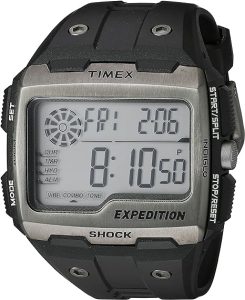
Weight: 2.7 oz | Waterproof: water-resistant| Dimensions: not available | GPS: no | Smartphone Compatible: no | Battery Life: not available
If you like large watches and retro design, then this model by Timex will definitely catch your eye. While it has that old-school look, this is still a modern watch with all the functions you need.
First, let’s talk about durability. This watch is built to withstand whatever is thrown its way. It has scratch-resistant mineral glass and a resin case with titanium hardware. It’s also worth noting that the watch is waterproof up to 330 feet!
Now, one feature I really like is the chronograph function. It allows you to track your “personal best” times, so you can always have your next fitness goal in mind.
The display might look simple, but you’ll have all the info you need. And thanks to the Indigo backlight, you can keep track of your stats – even on a starless night.
Pros
- Shock-, scratch-, and water-resistant
- Features hydration alarm
- Indigo backlight for nighttime vision
- 100-hour chronograph featuring lap and split times
Cons
- Quite bulky
Best for: hikers looking for a retro watch working on a coin cell battery
What To Consider Before Buying The Best Hiking Watch
You may be ready to pull the trigger on one of the watches above. However, those who are still on the fence will benefit from these four things they should consider before making their final buying decision.
If you’re yet to make a choice, then see the categories below:
Wristband
A wristband might not be the first feature you think of, but you should. After all, a wristband determines how well a watch sits on your wrist and how comfortable you are wearing it.
Traditionally, metal wristbands were the most popular. And it makes sense – they’re durable and low maintenance. Metal wristbands can also be quite comfortable around your wrist – unless it’s cold outside.
However, metal is not the lightest option out there. And in case it gets damaged when you’re out on the trail, fixing it on the go is practically impossible. Which is why other materials became more popular options.
One of them is silicone/rubber, which is very comfortable and fairly breathable. However, silicone wristbands are simply not as durable as other options, as they will wear out within a few years.
Nylon is breathable and decently strong as a wristband. It also dries down very quickly, which is important when you’re sweating or enjoying water activities. It’s not the comfiest option around your wrist, but its other characteristics make it on par with other materials.
Finally, leather is very pleasant on the eyes and comfortable around your wrist. But you don’t want to get it wet, as it can cause it to deteriorate much faster.
Glass
Since we’re talking about hiking watches, it’s clear that they need to be built to last. When doing such activities out in the open, a regular watch can easily get damaged. That’s why hiking watches are made with particularly sturdy materials – especially when it comes to glass.
There are several types of glass often used for hiking watches:
- Acrylic glass – This type of watch glass is made of a soft but durable plastic polymer. Its flexibility makes it incredibly impact-resistant and prevents it from shattering when damaged. Acrylic is also easily polished, which makes it a popular option for watches.
- Mineral glass – This type of glass is heat-hardened, so it’s even more difficult to get broken or scratched compared to acrylic. However, if scratched, it can’t be polished and needs to be replaced.
- Sapphire crystal – This material isn’t actually a type of glass. It’s made by crystallizing pure aluminum oxide at a very high temperature. Because of this process, this material is extremely strong and scratch resistant, but also expensive, which is why it’s usually found on high-end watches.
Water Resistance
Most hiking watches have a certain degree of water resistance, so whichever model you go with, you can rest assured a slight drizzle won’t cause it to stop working.
But, if you plan on going swimming or showering while wearing a watch, then you’ll need to make sure the watch in question has proper water resistance. Now, don’t expect to see the same water resistance ratings that you’ll see for tents and rain flies.
Instead, watches will typically have a water resistance of 50+ meters. Without getting too much into technicalities – if you want to swim while wearing a watch, you should make sure it has a water resistance of 100 meters.
Ease Of Use
A watch’s interface is another characteristic to keep an eye on. Some hiking watches have touchscreens, others have side buttons. And while buttons may be easier to use, a touchscreen does make navigation much simpler.
Therefore, there’s no single best option when it comes to ease of use. In reality, it depends on a specific model, how user-friendly its interface is, and your own preferences.
Battery Life
The first thing you should think about before you determine which hiking watch is right for you is your battery needs. If you generally go on short trips and charge your watch frequently, then there’s no reason not to go for something filled with features.
Sure, these extra bells and whistles may drain your battery faster. But in your case, that shouldn’t matter since you’ll always have enough juice left to make it back to a wall socket. This is even truer for those who keep their watches on low settings or bring a rechargeable battery pack with them.
On the contrary, long-distance backpackers who rarely have time to charge their watch might prefer a non-GPS model. GPS is a known battery drain, so keep that in mind. As we mentioned, you can always use a smartphone for navigation instead without sacrificing your watch’s battery life.
To Solar, Or Not To Solar
It’s undeniable that solar-powered charging is a very cool feature to have on your wrist. Still, it’s not always the most practical path forward. I’m not saying it’s not useful, but if you’re the type of person who wears your watch indoors most of the time, paying more for a solar cell just doesn’t make sense.
The same applies to those who use their hiking watch at night since there won’t be any sunlight around to get your battery life replenished. On the other hand, explorers who don’t want to get lost while exploring underground might find this feature invaluable.
Even if there’s no outlet to charge your watch, solar-powered watches allow you to get back to civilization whenever the sun shines. This is a lifesaver in the most real sense of the word — and thus a worthy investment if you ask me.
Not All Bells & Whistles Chime Equally
It’s always nice to see more features, but you should also pay close attention to which ones actually work the way they’re intended to. The thermometer on most hiking watches is an excellent example since many of them give inaccurate readings.
Why? This is because it mistakenly measures the temperature of your body instead of the temperature of your environment. This is bound to be off by a noticeable margin since your core temperature keeps your body warm. How warm? Quite a lot higher than the actual climate you’re faced with.
The compass is another feature that doesn’t always work as intended either. However, this is usually due to human error. You see, holding the watch parallel to the ground is crucial when using the compass; otherwise, it’ll malfunction.
Urban Functionality
While the name itself tells us that hiking watches are built for outdoor use, that doesn’t mean they shouldn’t live up to all your city-living needs. Paying hundreds of dollars for a watch is more justifiable when you get a product you can use in your day-to-day, too.
The Suunto we covered above is an excellent example of this since it manages to be as useful in a metropolis as it is in a rainforest. Its flashlight, fitness tracking, and smartphone-paired push notifications help in any backdrop.
If you already have a “daily driver” watch, then I’ll give you a pass on picking a watch dedicated to the wilderness. But even then, why not find something versatile to get more back for your buck?
Design
Finally, consider the design of the watch you’re spending your hard-earned money on. Looks aren’t everything, but there’s no harm in getting a product that isn’t totally ugly when you’re shelling out a chunk of change that huge.
Find something that you can wear anywhere. Bulky aesthetics may look great in the woods, but they won’t exactly fit in with your tuxedo on formal occasions. Sometimes, a subtler but more flexible design may be the way to go, especially if you often go to fancy dinners.
The same applies to businessmen who don’t want to switch watches before each meeting. At the end of the day, looks are about as subjective as it gets, so buy whichever design makes you happiest. Don’t overthink it since you really can’t go wrong when you’re shopping for yourself.
FAQs
What Is The Ideal Battery Life For A Hiking Watch?
Rarely any hiking watch can last longer than 30 hours in GPS. That’s why, ideally, you want a watch with different battery modes, so that you can switch between them for prolonged use.
Is It Necessary To Have GPS Functionality In A Hiking Watch?
GPS functionality is not a necessary feature. However, it can help you get detailed metrics for tracking purposes. What’s more, it’s a useful tool for navigation if you’re wandering onto new trails you don’t know as well.
How Important Is Water Resistance In A Hiking Watch?
Every hiking watch has a certain degree of water resistance. If you want to go swimming in your watch, make sure it has a water resistance of at least 100 meters. But, if you don’t plan on swimming while wearing it, you shouldn’t be bothered by those numbers too much.
How Accurate Are The Altimeter & Barometer Sensors In A Hiking Watch?
With proper calibration, hiking watches can have accuracy within 50 feet.
What Is The Ideal Size & Weight For A Hiking Watch?
Ideally, a hiking watch should be large enough to cover your wrist and weigh no more than two ounces.
Our Verdict
I hope this buying guide has taught you a thing or two and helped you decide which watch to go for. If you ask me which one is the best value, I’d definitely recommend you go for the Fenix 3 model from Garmin.
Its design and feature set make it city-ready without compromising the core outdoor functionality. You also can’t find a more gorgeous display on the market. It really helps when trying to read your GPS in the middle of a blinding afternoon.
That being said, if you favor the Suunto due to its longer battery life and urban-oriented construction, then there’s no shame in that either. It’s hard to go wrong when looking at such great options.
As we discussed in the previous section, battery needs can vary wildly from one use to the next. If you don’t mind missing out on a few features and prefer having a watch that’ll never die, then there’s no beating the Casio Pathfinder.
All in all, any of these five choices are sure to help your hike be more enjoyable and productive.
Know someone awful at navigating? Share this article with them, so getting lost can become a thing of the past. Trust me. They’ll thank you later.
That’s all for now, folks. Stay healthy, and stay wild!


